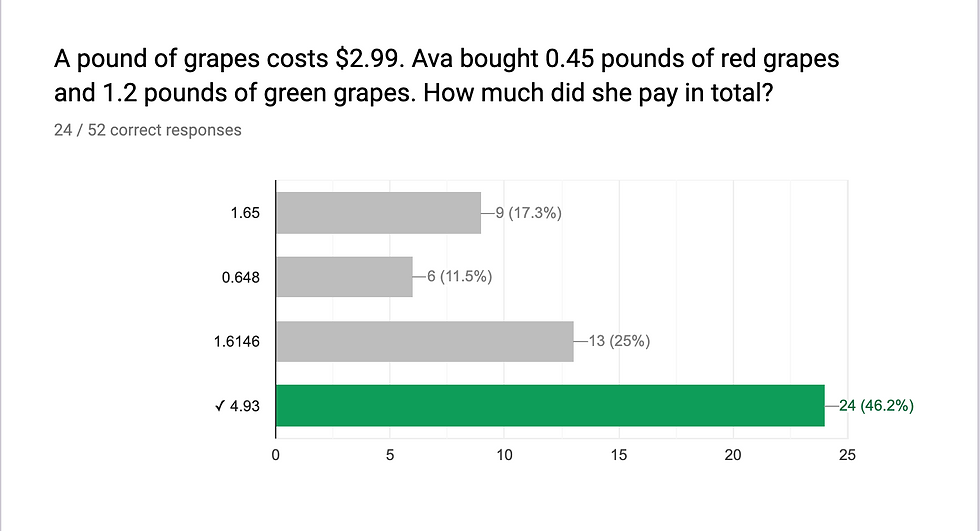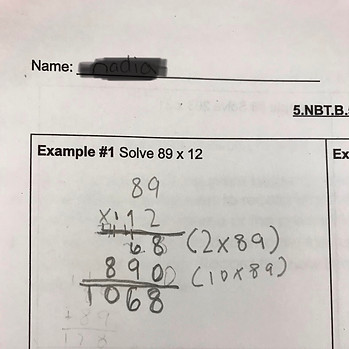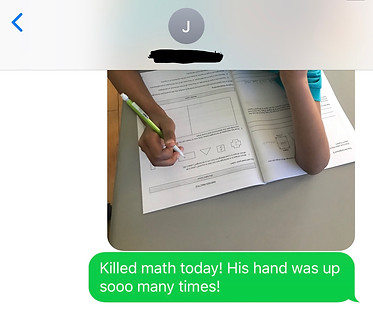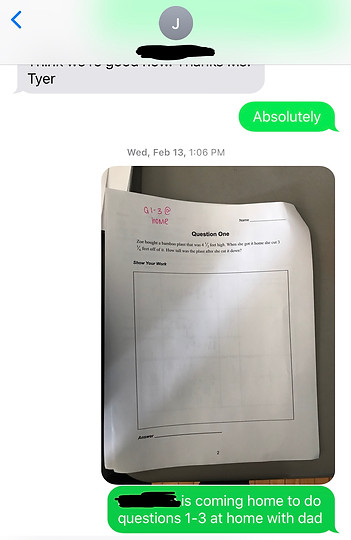Implementation of Instructional Strategies
Introduction
Instructional strategies are implemented at various points of the lesson. Illustrated below is evidence of surveys used to facilitate culturally responsive teaching, homework, and fluency used for procedural practice, technologies used during classwork to engage all student learning, and parent communication.
Tell Ms. T
In order to build relationships with students that will last, I must take the time to get to know my students. This demonstrates to them that I care about them as a person while portraying a holistic view of my students as learners. With more context into their life, their likes and dislikes, I am able to connect with them and support them better in their academic endeavors.
Below is a copy of the Google Form I use to collect information on students at the beginning of the year. Each of these questions was chosen intentionally to help me get to know the different characteristics of my students. This information is utilized when I construct my lesson to ensure they are culturally relevant as well as to form discussion starters during break/recess. Many students are surprised that I have taken this time during instruction. It has been their experience that teachers do not take the time to get to know them and therefore they have developed animosity against them. By completing this activity with my students each year, I immediately demonstrate to them my interest in them as individuals.

Example Information
Seen in the graph below is student's percentages that identify as the oldest, the middle or youngest child in their family. This is one example of information I collect to better understand my students and their families. As mentioned above this is a topic I can use to start a conversation by inquiring about their older and/or younger siblings. By having these types of conversations with my students I am able to learn more about who they are as individuals. For example, after reviewing student data, I learned that one student was the oldest in her family. When inquiring about her younger siblings she explained how her mom is having a baby. This helped me develop her leadership during class, connect with her, and form a genuine relationship with the family by contacting the parents with good wishes.

Additional Questions
-
When is your birthday?
-
Do you have any pets?
-
What do you like to do in your free time?
-
What is something you do well?
-
What do you want to be when you grow up?
-
I am happiest when...
-
What is something you are afraid of?
-
What is one goal you have for 2019?
-
What is your favorite TV show?
-
What is your favorite song?
-
What is your favorite snack?
-
What is your favorite drink?
-
What else would you like to tell me?
Implementation
The information collected from Tell Ms. T is used throughout the year to make lessons more culturally relevant to students. In the piece of evidence below, student input is used multiple times throughout the lesson to engage students in the lesson and ensure students feel a part of the planning process.
Homework
Each night students are assigned six problems on Google Classroom to continue this practice of procedural fluency. Similar to above, this practice allows students to become fluent in mathematical procedures such as multiplying decimals. Evidence of this development is seen below in this student's scratch paper from homework. The result of these strategies is discussed further in the Deep Understanding of Content Area section.

Shown above is an example of a student's homework. Before attempting the six questions assigned, students have access to a video from Khan Academy to review the material taught in class. This demonstrates a wide variety of resources, including human interactions through direct instruction and technology, being used to engage students in learning.




In the images above are exemplary student homework. Here students have shown their practice in conceptual understanding of multiplying decimals by scaling their factors. By doing this, students are able to multiply without decimals and divide to find their actual product at the end. The emphasis on ridding the factors of decimals and incorporating them at the end is important to create a deep understanding of content areas necessary to develop higher level thinking.



The data shown from this homework assignment demonstrates students development in multiplying decimals fluently in order to access higher-level thinking problems. Question #1 asks students to solve 2.1 x 0.54 with a mastery of 73.1%. Although this number is high it demonstrates students have not yet mastered the skill. The impact is seen in the second image when only 46% of students were able to apply this skill to other skills and demonstrate higher-order thinking. For this reason, the instructional strategy of fluency is important to provide students with further practice.
Fluency
At the beginning of each class, I utilize fluency work to build students procedural understanding of math. Fluency work is practice on just the procedure of math. By drilling these procedures these skills become secondary to higher-level thinking. This demonstrates an understanding of the cognitive processes necessary for higher-order thinking. In the lesson below, students engaged in fluency and homework that build their skill of multiplying decimals.

In the piece of evidence to the left, this student places an emphasis on partial products allows students to build their fluency in standard algorithm alongside rationale. As I strive to build a deep conceptual understanding of mathematics in my class, it is important students practice skills such as this to be able to justify their product.
Khan Academy Test Review
An instructional strategy used during class to support student's skill development through media and technology is Khan Academy. This strategy is used to help students prepare for tests. This instructional strategy is used during this time to meet the needs of various students. In the piece of evidence below students, different needs are highlighted. By adapting to the needs of individual learners, students are able to review material that is most relevant to them. At this point in the unit, it is expected that students need personalized learning plans to close their individual misconceptions; interaction with Khan Academy allows me to support my students in this way.
In the video evidence above, this student is seen capturing notes while watching the videos. This demonstrates how a number of resources can support students cognitive processes differently. Although we took notes throughout the unit and captured our learning in a packet, this student demonstrated more learning from watching videos independently. This allowed him to prepare for the assessment in a way that best supports his learning style.

The data shown on this page of Khan Academy allows me to see which activities students completed and how they did. Based on the data, some students took the assessments without watching the videos while others only watched the videos. This type of live proctoring allows me to monitor student learning and respond appropriately. For example, the student who only watched the videos was given a one-on-one check in to spark her confidence for an assessment.
Parent Communication
It is my belief that parents are partners. While raising a child takes a village so does teaching a child. With this understanding, there are a number of strategies I use to maintain consistent parent communication that helps parents support their children at home and at school. Throughout the day I will be communicating with parents about behaviors (positive or negative) as well as academic progress. This type of communication allows me to build a consistent relationship for students between school and home. This is a strategy that I have flexibly adapted to help gain students investment in the classroom. I am committed to using a variety of technology (text message and email) to help support and promote student learning in a meaningful way. The result is greater trust and academic success.

As mentioned above, I frequently communicate with parents throughout the day. Shown below are two different screenshots of text messages I have sent throughout the day to parents. The image to the left is a message I sent to a parent whose child was truly showing up in class. This student has faced multiple challenges in math class this year. For this reason, it is important to me that this parent received positive communication when their child is performing highly in order to build a strong repertoire.
The image to the right is a message I sent to a parent whose child was struggling with multi-step word problem involving fractions. Throughout the year, I have worked to build a relationship with this family. From this, I was able to learn that the student's father was a math teacher. While this student struggle with math, we worked together to identify best practices to support him at home. Consistent communication about problems that can be practiced at home has allowed this student to grow from not proficient to proficient in mathematics this year.


As part of Achievement First's Greenfield Model, each teacher is assigned a goal team fo 10-12 students within their homeroom. This teacher is responsible for maintaining consistent communication with each family in regards to academics as well as each student's social-emotional experience. In order to keep parents aware of all content areas and school announcement, I have chosen to send a weekly goal coach update. Within this email is a blurb for each content area that previews the upcoming week's objectives, assessments, and/or homework assignments. As their math teacher, I choose to incorporate links to videos to support learning at home. An example email is shown below.
Conclusion
As seen in the evidence above, there are a number of instructional strategies I use each day to encourage learners to develop a deep understanding of content such as homework, fluency, and Khan Academy. Each of these strategies demonstrates an ability to apply a range of developmentally, culturally, and linguistically appropriate strategies to help all students achieve. By flexibility adapting instruction to be culturally responsive through survey information and parent communication, I have been able to gain reciprocated learner response, ideas, and needs that help develop a community within my classroom.